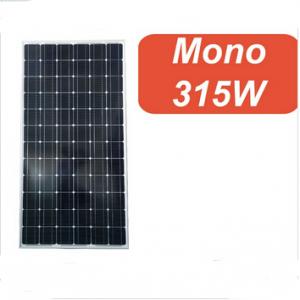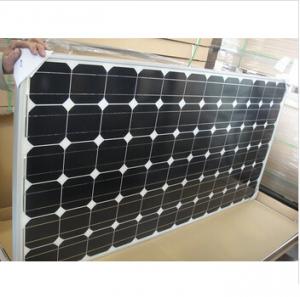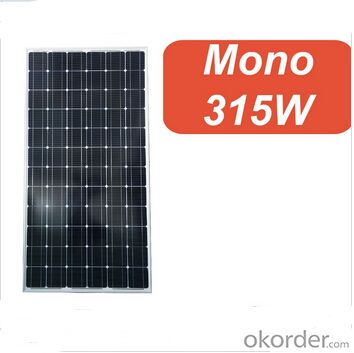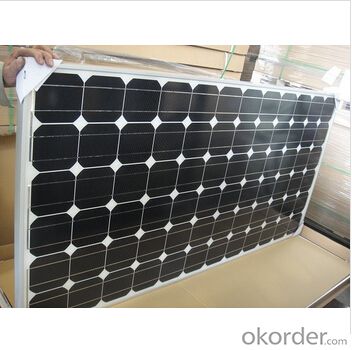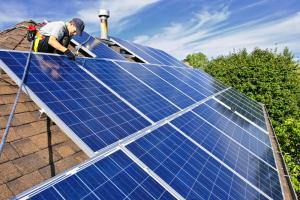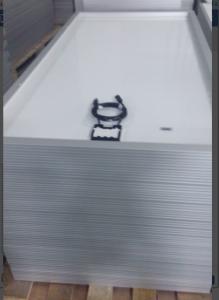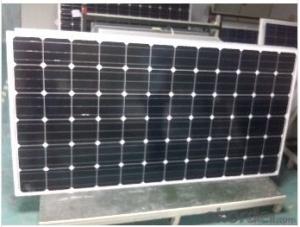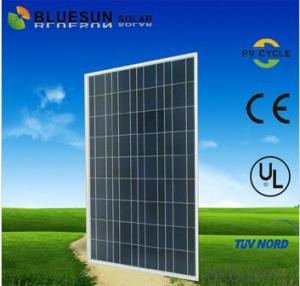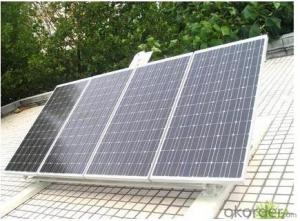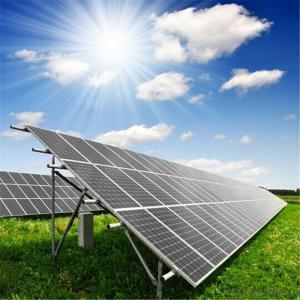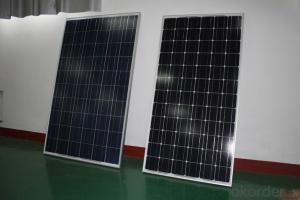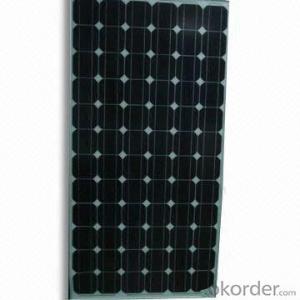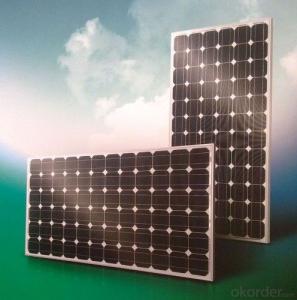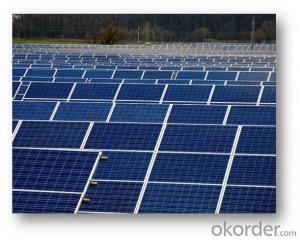Green Energy Solar Panels - Monocrystalline 315W Solar Module
- Loading Port:
- SHANGHAI
- Payment Terms:
- TT or LC
- Min Order Qty:
- -
- Supply Capability:
- 10000000 watt/month
OKorder Service Pledge
OKorder Financial Service
You Might Also Like
Description:
Solar modules use light energy (photons) from the sun to generate electricity through the photovoltaic effect.
The majority of modules use wafer-based crystalline silicon cells or thin-film cells based on cadmium telluride or silicon.
The structural (load carrying) member of a module can either be the top layer or the back layer.
Cells must also be protected from mechanical damage and moisture. Most solar modules are rigid, but semi-flexible ones are available,
based on thin-film cells. These early solar modules were first used in space in 1958.
CNBM Solar photovoltaic (PV) Panel is designed for large electrical power requirements.
It is the optimal choice for both on-grid and off-grid power systems.
CNBM Solar panel offers high performance of power per square foot of solar array.
Monocrystalline silicon(c-Si): often made using the Czochralski process. Single-crystal wafer cells tend to be expensive,
and because they are cut from cylindrical ingots, do not completely cover a square solar cell module without a substantial waste of refined silicon.
Hence most c-Si panels have uncovered gaps at the four corners of the cells.
Characteristics of Solar Monocrystalline
I. Solar Cell : High efficiency crystalline solar cell.
Even if under the weak light, the solar module can produce maximum power output.
II. Tempered glass (toughened glass): Anti-reflecting coating and high transmission rate glass increase
the power output and mechanical strength of solar module.
III. EVA and TPT: Using high quality EVA and TPT to prevent destroying and water.
IV. AI frame: Without screw, corner connection. 6 holes on the frame can be installed easily.
V. Junction box: Multi function junction box with water proof.
VI. Long lifetime: ≥25 years; Less power decrease.
VII. Good performance of preventing from atrocious weather such as wind and hails.
VIII. Resisting moisture and etching effectively, not effected by geology.
IX. The certificate issued by international authority: UL, TUV, IEC, VDE, CE.
Standard Test Conditions of Solar Monocrystalline
The opto-electrical specifications shown below are stabilized values being measured at Standard Test Conditions,
Irradiance: 1000W/m2, Spectrum: AM1.5 at 25°C, The info below is subject to manufacturing tolerances.
Where appropriate minutes of measurement are available and are used for the dimensioning of the installation.
Maximum Power (Pmax) | W | 315 |
Power Tolerance | W | (0,+5) |
Maximum Power Voltage (Vmp) | V | 37.5 |
Maximum Power Current (Imp) | A | 8.4 |
Open Circuit Voltage (Voc) | V | 46.30 |
Short Circuit Current (Isc) | A | 8.95 |
Module Efficiency (ηm) | % | 16.23 |
Dimension of module | mm | 1956*992*40mm(77.0*39.1*1.6inch) |
Pmax Temperature Coefficient | %/C | -0.44 |
Voc Temperature Coefficient | %/C | -0.32 |
Isc Temperature Coefficient | %/C | 0.44 |
Maximum System Voltage | VDC | 1000(TUV);600(UL) |
Maximum Series Fuse Rating | A | 15 |
Operating Temperature | C | -40~ +85 |
NOCT | C | 45±2 |
STC:1000W/m2.AM1.5 and 25C cell temperature, NOCT : Nominal Operating Cell Temperature | ||
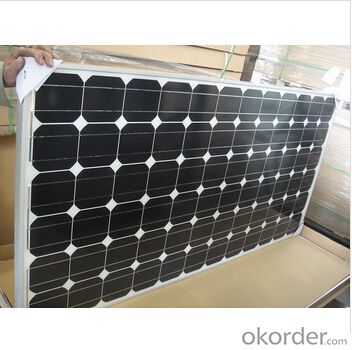
FAQ:
1. How long will my inquiry get response?
Your inquiry related to our products or prices will be replied within 24 hours.
2. Can I get professional service and suggestion?
Well-trained and experienced staffs to answer all your questions in fluent English.
3. Do you accept OEM or customized design?
OEM & ODM, any your customized lightings we can help you to design and put into product.
4. What if I need specific design?
Distributorship are offered for your unique design and some our current models.
- Q: Can solar panels be installed on a south-facing wall?
- Yes, solar panels can be installed on a south-facing wall. In fact, a south-facing wall is often the most ideal location for solar panel installation as it receives the most direct sunlight throughout the day, maximizing energy production.
- Q: Can solar panels be used in areas with high levels of insect activity?
- Yes, solar panels can be used in areas with high levels of insect activity. While insects may occasionally land on the panels, their presence does not significantly affect the performance or efficiency of solar panels. Proper installation and regular maintenance can help minimize any potential issues caused by insects.
- Q: Can solar panels be installed on golf courses?
- Yes, solar panels can be installed on golf courses. In fact, golf courses provide ample open space and sunlight exposure, making them suitable for solar panel installations.
- Q: Can solar panels be installed on a swimming pool?
- Yes, solar panels can be installed on a swimming pool. In fact, many pool owners choose to install solar panels to heat their pools and reduce energy costs. The panels absorb sunlight and convert it into energy to heat the water, extending the swimming season and making the pool more comfortable for users.
- Q: Are there any safety concerns with solar panels?
- Yes, there are some safety concerns associated with solar panels. These include the risk of electrical shock during installation or maintenance, the potential for fire hazards due to faulty wiring or overheating, and the handling of toxic materials during the manufacturing and disposal processes. However, these concerns can be mitigated through proper installation, adherence to safety regulations, and use of high-quality components.
- Q: Do solar panels require regular cleaning?
- Yes, solar panels do require regular cleaning to ensure optimal performance. Dust, dirt, and other debris can accumulate on the surface of the panels over time, blocking sunlight and reducing their efficiency. Regular cleaning helps to remove these obstructions and maximize the energy output of the solar panels.
- Q: How long do solar panels last?
- Solar panels typically last for about 25 to 30 years, although some can continue to generate electricity for even longer with proper maintenance.
- Q: So you know how the bigger the surface area exposed to the heat radiation means the quicker it'll heat up.Is this what happens with solar panels, they have a large surface area exposing to the sun, so they can get more heat?
- - Radiation from the sun is mostly Ultra- Violet. - There are 2 types of solar panels, Solar thermal collectors and photovoltaic cells. - Put simply, photovoltaic cells take the UV rays and produce electricity. - Solar thermal collectors (which is probabl
- Q: Are solar panels fire hazards?
- Solar panels are generally not considered fire hazards. While there have been some isolated incidents of fires related to solar panels, they are extremely rare and typically caused by faulty installations, damaged equipment, or external factors. When installed properly and maintained regularly, solar panels pose no significant fire risk.
- Q: Can solar panels be installed on a commercial building?
- Yes, solar panels can be installed on a commercial building. In fact, many businesses and organizations are increasingly adopting solar energy to reduce their carbon footprint and save on energy costs. Installing solar panels on commercial buildings can help generate clean, renewable energy and contribute to a more sustainable future.
Send your message to us
Green Energy Solar Panels - Monocrystalline 315W Solar Module
- Loading Port:
- SHANGHAI
- Payment Terms:
- TT or LC
- Min Order Qty:
- -
- Supply Capability:
- 10000000 watt/month
OKorder Service Pledge
OKorder Financial Service
Similar products
Hot products
Hot Searches
Related keywords
